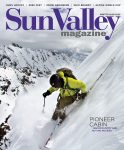“A good photograph is knowing where to stand,” Ansel Adams once said about the importance of intelligent composition. Yet behind many of today’s nature images there is no photographer; the camera stands alone, waiting or clicking to a timer. Of course with every photo there is direction, framing, setup. But more and more images are being captured remotely, through the use of advanced cameras that can operate without assistance. The growing use of such techniques in the last decade has led to an exciting wave of photographic possibilities (i.e. all the best scenes in Planet Earth). This month Ketchum plays host to two speakers, Matthew Deren and James Balog, both of whom have chosen remote photography to gain fresh insights into their subject matter.
Speaking at the Community Library last week, Matthew Deren explained that he wasn’t a professional photographer. His new book, “A Forgotten Wilderness: The Hidden Relationships of a Changing Continent,” however, is 176 pages of breathtaking photos that he took over two years, while exploring a secluded niche of backcountry in West Central Idaho. Matthew openly explained his remote process. Many of the book’s images he captured with heat and motion sensor cameras, which he would set up and abandon for days. Only by leaving the scene entirely was Deren able to gain visual access to the area’s abundant community of mountain lions, bears, elk, bobcats, moose, wolves, coyotes and more. Not only did his remote photography create more photo opportunities, but it anchored Deren’s goal of removing himself from the narrative.

Courtesy photo.
“Most books are about the photographer, who explores wildlife while also discovering himself,” Matthew said. He continued on to describe the meticulously framed shots, like a “heroically-poised elk,” which almost communicate more about the values of the cameraman than what’s actually going on. Deren hoped to create a different book of environmental photography, one filled with honest glimpses of nature. Part of why he felt so strongly about this dehumanized approach was due to the sheer uniqueness of the world he’d discovered in Central Idaho.
Forming a loose triangle between McCall, Stanley and Challis is the largest patch of undisturbed temperate forest in the continental United States. Preserved by its steep terrain, it has a greater variety of flora and fauna than both nearby Yellowstone and the Cascades. Matthew explained that the area’s transitional climate is responsible for the bounty of wildlife. West Central Idaho sits in a North American transitional zone, meaning species native to the Great Basin, such as the Burrowing Owl, are found only miles apart from those native to the Pacific Northwest, like the Northern Spotted Owl. Basically the climate allows for the convergence of multiple ecosystems, and is therefore able to support an absolute bounty of species.

An environmental consultant by profession, Deren knew he’d stumbled into somewhere special. And because of the region’s isolation, he realized that ecological patterns destroyed elsewhere could potentially be re-discovered in Central Idaho. The story of this wilderness, he thought, would have to be a story of relationships and connections in nature. Human-less and yet full of life. During his talk, Deren described through his photos how bobcats shadow mountain lions, consistently one or two days behind the bigger predator. He talked about the winter relationship between the elk and the magpie, and the way the fox avoids the coyote. I spoke with Matthew after the lecture about the bigger picture. How did he tie what he saw together? “Nature is really just about patterns,” he said, “that’s it.” Let the camera stand alone and allow nature reveal itself. By inserting our own biases into every photo, we lose track of what’s truly happening: the subtle interactions and patterns of the world around us. For Matthew Deren, “A Forgotten Wilderness” was his chance to forsake “the animal causing a traffic jam” and to remotely sketch a real story.
Check back in with sunvalleymag.com later this week for a write-up on renowned environmental photographer James Balog's talk at Presbyterian Church of the Big Wood, as a part of the Sun Valley Center for the Arts Lecture Series, focusing on his photographic study of glaciers.



